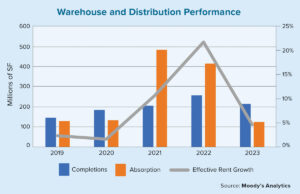Returning to work. These three simple words have become a dreaded demand by some, a cliché to others and generally unclear to many. What does it mean to return to work in a world where many employees would prefer to work from home? Companies large and small are wrestling with how to meet the needs of employees while also doing what is best for the business.
This workplace struggle is resulting in real opportunities for commercial mortgage brokers to help their clients develop new strategies in how they think about the office sector, including the concept of hybrid work. In recent years, returning to the office has been a different experience for those who have been resistant to change and those who have embraced it. The companies that are thriving are those that have seized this time of change to rethink how they grow and manage their teams — and how they use the space that their teams need to operate effectively.
“This unprecedented era of change means that mortgage brokers have an opportunity to transform their relationships with business clients.”
Those who are entrenched in a pre-pandemic mindset may be missing out. Stubbornly focused on traditional ideas of team management, they are not embracing a new approach. In so doing, they may be falling behind their competitors.
This unprecedented era of change means that mortgage brokers have an opportunity to transform their relationships with business clients and help those eager to embrace opportunity to find new office space options. It is also a chance to help those who are resistant to such changes in facing a new reality.
Acknowledge the fear
The clients who are resistant to a more permanent shift in their return-to-office strategy have legitimate fears and concerns. Mortgage brokers must recognize and validate these feelings.
Businesses that require employees to return to the office in a pre-pandemic style often cite a desire to increase productivity, enhance corporate culture, create opportunities for junior staff to learn from peers, and other logical business reasons. Executives fear their staff members will miss out on these opportunities by shifting into any new variation of hybrid working.
Others may see the opportunity but fear their ability to manage hybrid working equitably. Lacking traditional and consistent human resources policies around hybrid working, they simply discard it from consideration. It is not too difficult for them to imagine future lawsuits where workers allege favoritism or discrimination based on unenforceable hybrid working guidelines.
These are all legitimate fears, especially for large multinational businesses with complex work dynamics. But fear-based decisionmaking seldom leads to progress in business or life. And while they may resist change for these reasons, various studies have found no evidence to support these positions.
Presenting the facts
Once the fears of clients are acknowledged, they can then be presented with information that can help them find solutions. But first, they need to know what employees expect today in their work environment.
Research shows that a hybrid work schedule is much more popular than working from the office. According to the business consulting firm McKinsey & Co., 87% of employees will work flexibly when given the chance. The consulting company Accenture has reported similar survey results.
The research is clear that most employees want more agency over their time and where they work. Some executives may argue that they are not in business to serve their employees. They may think their companies are either too big or too unique to need to address the fact that the vast majority of their employees expect to have some form of hybrid work option. But when fundamental shifts in human behavior and expectations become this evident, ignoring the trend would be akin to telling the now-defunct Blockbuster Corp. it was right to turn down the chance to buy Netflix’s mail-order DVD business.
If recognizing these trends in human behavior isn’t enough, looking at the performance of businesses that are adopting strategic changes may hit harder. Job recruitment website Zippia estimates that 74% of U.S. companies are currently using or planning to implement a permanent hybrid work model. What’s more, 63% of “high-growth” companies use a “productivity anywhere” work model, a hybrid approach that combines the benefits of remote and in-office work.
In other words, the majority of the companies that are growing the fastest are doing so by adopting a hybrid work model, which means they are adjusting their commercial real estate strategy. If they use less traditional space, they use the space they have more effectively and strategically. Blending on-site offices and meeting spaces with off-site workplaces is a tricky needle to thread, but it’s one that experienced real estate and mortgage professionals are able to accomplish.
Finding solutions
Once clients understand the facts about changing workforce attitudes and the success of other businesses in adapting to the reality of hybrid work, it’s time to get specific about finding solutions. It can seem counterintuitive for mortgage brokers, whose livelihoods depend upon clients using commercial real estate, to suggest that clients might use less of it or use it differently.
The reality, however, is that when the real estate finance industry can deliver solutions that truly meet clients’ business objectives, everyone wins. There isn’t necessarily less pie to go around. The pie is just valued differently. Your business depends upon your clients’ use of commercial real estate, but you need to help them do so strategically and to create tailored solutions.
For instance, a Seattle-based biotechnology company experiencing rapid growth needed to expand its space to accommodate both lab and office needs. Because their mortgage brokerage took the time to understand the business and the technical requirements necessary for complex genetic research, they were able to find a property that consisted of 30% office space and 70% lab space.
The broker then worked with the owner and landlord to ensure that current and future equipment, as well as the power supply, would be available for work that could not be done remotely. Meanwhile, accommodations could be made for those who were utilizing a hybrid work model. Thinking about current and future needs gave the broker the opportunity to provide a long-term solution that could meet the evolving needs of the client.
New spaces
No matter who the client is, the broker’s focus remains on solutions for physical spaces. This can look differently for different clients. Here are some approaches that have proven successful:
• Providing dynamic designs and exciting spaces can accommodate both collaborative and individual work.
• Using technology to track patterns of usage can inform your clients’ approach to hybrid work.
• Embrace sustainability as an opportunity, not a compliance process. By reducing environmental impacts and the associated costs in one area, a business might be able to reinvest in space improvements or a more desirable location.
Rethinking the use of space will open up new opportunities for mortgage brokers and their clients. Since much of the research can point to irrefutable facts about the future of work, sharing personal success stories and the success of clients makes it real. So, find your personal stories and point to ways you or your clients have personally thrived in this new approach to working.
● ● ●
In the end, mortgage brokers are in this business to serve the best interests of their borrowers. This means providing modern thinking and informed strategies for improving a client’s workplace. Remember, success isn’t found in the amount of space you broker but in helping your clients use space wisely. ●
Author
-

Mark Wanic is president and chief operating officer of Pacific Program Management, where he executes the company’s business strategy while leading day-to-day operations and client growth. With more than 30 years of experience recruiting, organizing and leading diverse global organizations and teams, Wanic’s expertise spans several business sectors, including the commercial real estate industry. His industry experience has resulted in elevated client service, attraction and retention of superior professional talent, and the driving of significant business growth.




